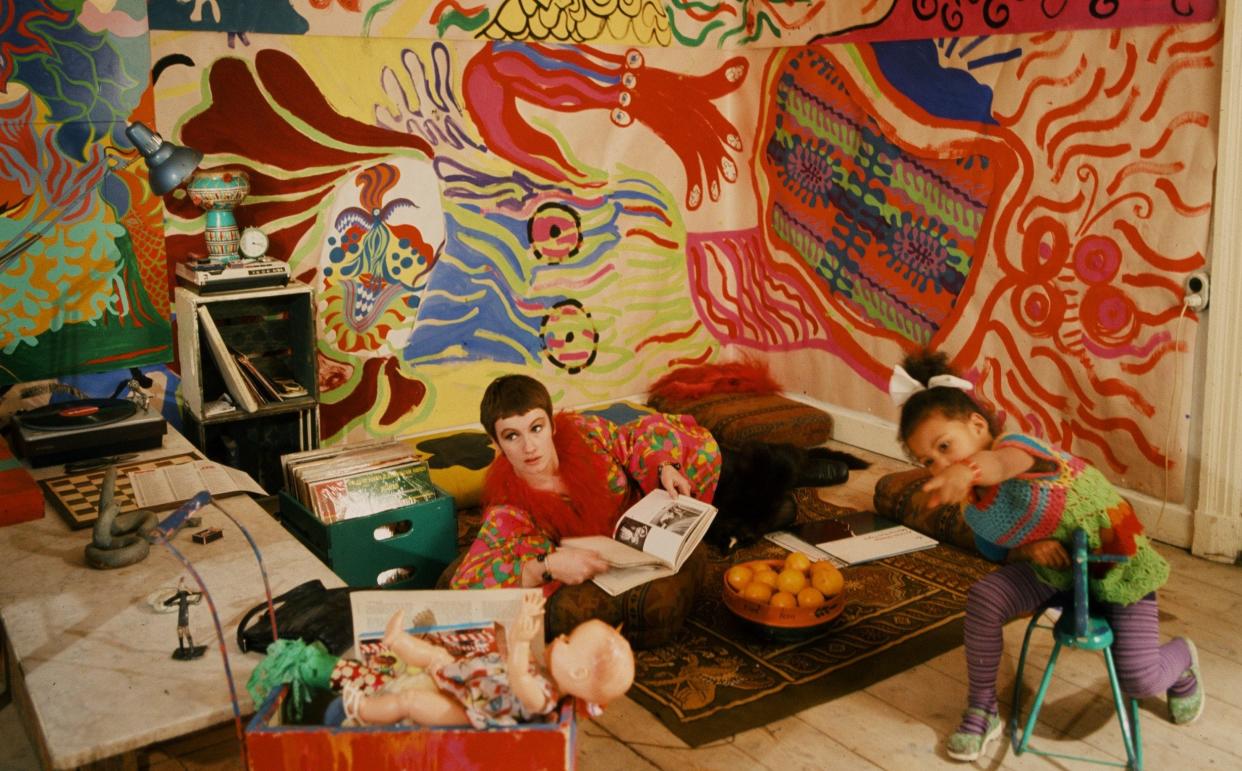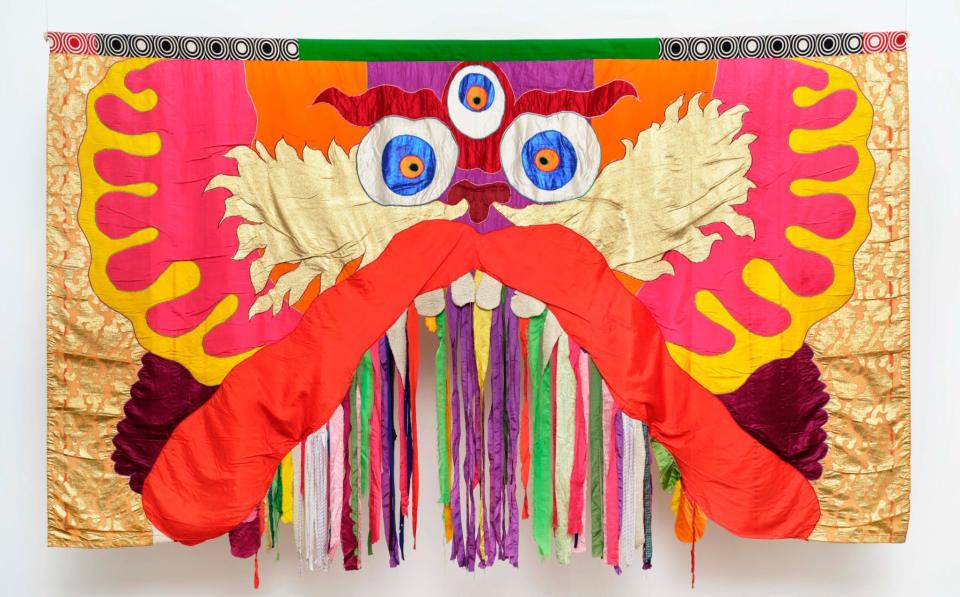Neneh Cherry: ‘Looking at my mother’s art breaks my heart’

When I was a child, my mother Moki Cherry liked to work close to the floor. Her sewing machine perched on a low table, the legs sawn down. She’d sit there, fabric spilling everywhere, the machine working away as she made tapestries, our clothes, bags to pack for our travels around the world. The Singer’s rhythmic hum was like a lullaby, a calm nightlight over her late-night sewing sessions. The sound covered me like a security blanket and soothed me to sleep. I have a distinct memory of my mother as she worked: the way she sat with her head slightly tilted down. This posture remained a constant throughout her lifetime. It had an intensity and focus, silent and loud as she worked with absolute precision. I would think of her in that position long after I’d left home – and instantly, I’d be right back there with her.
My mother was born Monika Marianne Karlsson in Norrbotten, Sweden, in 1943. Her father was a station-master; her mother ran the local post office. After apprenticing in fashion studios, and then studying at the renowned Beckmans College of Design in Stockholm, she found her own voice. Her art is full of bold colours, morphing creatures, universal symbols and words. She created intense, expressive worlds in her paintings and tapestries. The most important source for my mother’s creativity was life itself. How she lived – and how we lived as a family – was always an ongoing, conscious commitment to the idea of creativity and life coexisting, overlapping and influencing each other. The art she made became a part of our home – as were instruments from around the world, treasures discovered in flea markets, food grown in the garden.
The ideas were both big and small, homegrown and free, but I think my mother’s investment in the process had a very disciplined execution which took a lot of dedication. She decided very early on to make her family a creative collaborative journey, but the demands made of women are many and complex: family and home life always come with a cost and sacrifice. As a kid, I could feel how vital my mother’s art was. My brother Eagle-Eye and I would get on with our own things, playing around her – she emanated a peaceful, contagious energy, and we knew to respect it. But I know, at times – like all mothers – she struggled to find the space she needed to be by herself and get her own work done. It’s something I’m very aware of when I look at her art now. Yet my overriding feeling whenever I see her work is of its sheer intensity, vibrancy and timeless energy. I am struck by how my mother’s voice is unapologetic, fearless, playful, and always a few steps ahead of the curve. Though sometimes, since her death in 2009, looking at her art can break my heart because I miss her every day – so very much – and because it’s clear that there is no one else like her.
These days, the world seems in love with beiges and greys. But there was nothing insipid in the way my mother used colour and texture, and she hunted for it from city to city. She found a lot of her fabrics in the Parisian neighbourhood of Barbès, where there was a street lined with fabric stores. The energy was always loud, definitely intense and packed to the max. My brother and I might get desperate in the end – “Please, please mamma we want to go back to the hotel!” – tired of all the ladies pushing us around. But off we trotted to another shop to buy more silks. In New York, Moki would carry scissors in her bag – always handy because downtown in SoHo during the 1970s, a lot of the warehouses were still garment and upholstery businesses. Much to my horror, I would watch as my mother climbed into skips to fill her bag with discarded scraps of unused fabric.
In 1963 in Stockholm, Moki, then a 19-year-old student, met my stepfather Don Cherry. He played the trumpet like no one else. Don, an African-American – born in Oklahoma and raised in Watts in LA – was on tour with saxophonist Sonny Rollins, playing at the city’s Concert Hall. That night after the gig, while watching falling snow, they talked about love and collaboration as a way of life. And that’s exactly what they did, for as long as they could. Don came back to Sweden only a few months later, spent a night at Moki’s apartment and when he woke up in the morning she had dyed all his long underwear pink. (He always said that’s when he knew she was the one.)

I know how deeply inspired my mother was by the music Don played but equally I see how Moki’s visionary spirit helped him find a part of himself that was waiting to be liberated. When Don stayed in Stockholm with my mother, it gave him a chance to study music of the world on a deeper level, and he started composing more music of his own.
My parents began a creative collaboration, which they later called Organic Music. It started with the idea of wanting to elevate music beyond stinky, smoky jazz clubs run by dodgy men, into performances that fused Don’s music and Moki’s stage settings filled with her wild textiles. It was the era of live “happenings”, so they started seeking other types of venues for their performances. Moki crafted all the costumes for the musicians, made her own fabric prints for the stage designs, painted flyers for the gigs and illustrated record covers. It inspired her to use the same ideas with fabric that would later develop into her incredible tapestries.
We didn’t go on family holidays: we went on tour. In Europe, we usually travelled in our VW bus, a house on rolling wheels. At each new venue, Eagle-Eye and I would hang out, playing games; sometimes we would sleep next to the stage. Meanwhile, our mother might be up a ladder, hanging her tapestries in preparation for another concert. I loved the way she would issue directions to the stage hands working below. My mother believed that “the stage is home and home is a stage”.

The duality between our home in the Swedish countryside and the streets of New York had a natural rhythm. Somehow these extremes complemented each other – hardships and all. My parents wanted us to be proud of who we were, to understand where we came from but also to know the world. In Sweden we had moved into an old schoolhouse, our home, but sometimes the stage for live music, exhibitions, plays and film screenings. In 1977 we had our first permanent home in New York, a loft in an old factory in Long Island City, where people like the Talking Heads also lived. Later, Moki began working more as an artist in her own right, focusing on her solo work. The tapestries she made in the 1980s are some of my favourites. She also started constructing plywood light-box sculptures, then collages and ceramics – all drawing on and feeding back into the life around her.
It’s weird, yet sometimes an artist has to die before they are taken seriously. Moki worked with compulsive energy but not without frustration knowing her own worth, especially in her later years when the lack of recognition had started to sting. But here we are; her time is now. Moki’s work will be the subject of an exhibition at the Institute of Contemporary Arts in London. I’m glad that her art can speak to new generations, and still look to the future. I’d hate it if it became something nostalgic, a thing of the past. And it’s wonderful that her first show in the UK will be at the ICA, a space I’ve had a happy relationship with since I moved to London in 1980: I’ve played gigs there, gone to parties and seen amazing art.
Moki, my mother, lives on in the incredible work that she made and through the full life that she lived. But her creative drive also lives on in our multigenerational family: a gift to be passed down. My eldest daughter Naima – an artist and musician – helped Moki prepare for exhibitions in her later years, and has taken on the lion’s share of caring for her legacy. An understanding of her grandmother is in her blood; and now she is co-curating the show at the ICA. The other day, Naima told me that her son – my grandson – Flynn, a fashion and design student, had been up working all night, the sound of his sewing machine still humming at 3am. How deeply familiar.
Sometime in the 1990s, my mother gave me one of her artworks: an illuminated sculpture, made from plywood, in the form of a camouflaged heart. A figure sits at the front of the sculpture with a red lightbulb behind its face that lights up the eyes. It’s been with us for decades, from country to country and home to home, watching over my children as they’ve grown up. At the time of writing, it’s hanging in my youngest daughter Mabel’s house, like a guardian angel. But in a few days we will gently take it down and wrap it up safe to carry it from west London to The Mall to hang out at the ICA for a while, spreading its wisdom to others. I like that. It only seems right.
Moki Cherry: Here and Now is at the ICA, London SW1 (ica.art), from Wednesday


